Exercise 3
1. State which pairs of triangles in Fig, are similar. Write the similarity criterion used by you for answering the question and also write the pairs of similar triangles in the symbolic form :
(i)
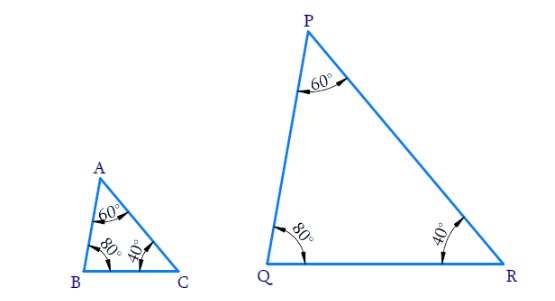
In ΔABC and ΔPQR
∠A = ∠P =
∠B = ∠Q =
∠C = ∠R =
All the corresponding angles of the triangles are
By AAA criterion ΔABC ∼ ΔPQR
(ii)
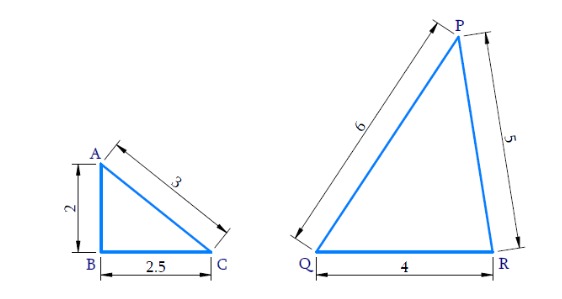
In ΔABC and ΔQRP
⇒
All the corresponding sides of the two triangles are in the same proportion.
By SSS criterion ΔABC ∼ ΔQPR
(iii)
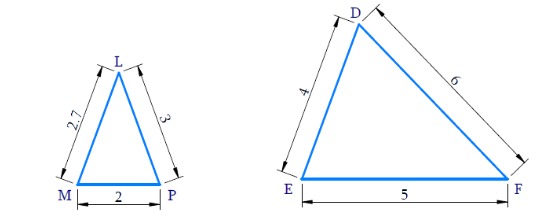
In ΔLMP and ΔFED
⇒
All the corresponding sides of the two triangles are not in the same proportion.
Hence triangles are not similar. ΔLMP ≠ ΔFED
(iv)
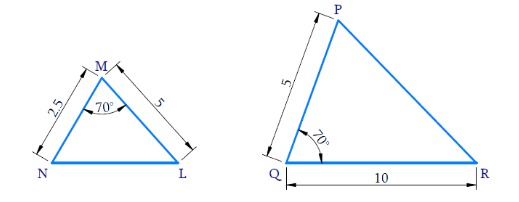
In ΔNML and ΔPQR
⇒
∠M = ∠Q =
One angle of a triangle is equal to one angle of the other triangle and the sides including these angles are proportional.
By SAS criterion ⇒ ΔNML ∼ ΔPQR
(v)
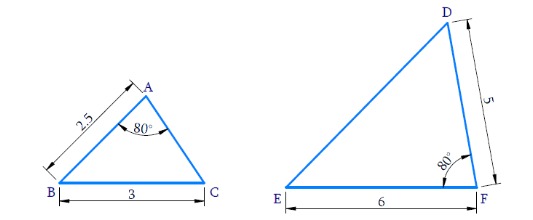
In ΔABC and ΔDFE
∠A = ∠F =
But ∠B must be equal to
The sides AB, BC includes ∠B , not ∠A
Therefore, SAS criterion is not satisfied
Hence, the triangles are not similar, ΔABC ≠ ΔDFE
(vi)
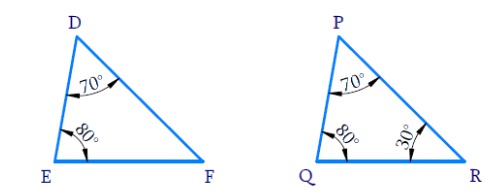
In ΔDEF
∠D =
⇒ ∠F =
Similarly, In ΔPQR ∠Q =
⇒ ∠P =
In ΔDEF and ΔPQR
∠D = ∠P =
∠E = ∠Q =
∠F = ∠R =
All the corresponding angles of the triangles are
By AAA criterion ΔDEF ∼ ΔPQR
2. In Fig, ∆ ODC ~ ∆ OBA, ∠ BOC = 125° and ∠ CDO = 70°. Find ∠ DOC, ∠ DCO and ∠ OAB
Solution:

In the given figure,
∠DOC =
∠DOC = 180° -
∠DOC =
In ΔODC, ∠DCO = 180° - (∠DOC + ∠ODC) [angle sum property of a triangle]
∠DCO = 180° - (55° +
∠DCO = 180° -
∠DCO =
In ΔODC and ΔOBA
ΔODC ∼ Δ
⇒ ∠DCO = ∠
Thus, ∠OAB = 55°
3. Diagonals AC and BD of a trapezium ABCD with AB || DC intersect each other at the point O. Using a similarity criterion for two triangles, show that
Solution:
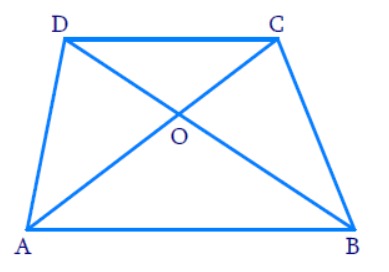
In ΔAOB and ΔCOD
∠AOB = ∠
∠BAO = ∠
⇒ ΔAOB ∼ Δ
Hence,
4. In Fig,
Solution:

In ΔPQR, ∠1 = ∠
⇒ PR =
In ΔPQS and ΔTQR
∠PQS = ∠TQR = ∠
⇒ ΔPQS ~ Δ
5. S and T are points on sides PR and QR of ∆PQR such that ∠P = ∠RTS. Show that ΔRPQ ~ ΔRTS
Solution:

In ΔRPQ and ΔRTS,
∠RPQ = ∠
∠PRQ = ∠
Thus, ΔRPQ ∼ Δ
6. In Figure, if ∆ABE ≅ ∆ACD, show that ∆ADE ~ ∆ABC.
Solution:

In ∆ABE and ∆ACD
AD =
AB =
Now Consider ∆ADE and ∆ABC
and ∠DAE = ∠
Thus, ∆ADE ~ ∆
7. In Fig, altitudes AD and CE of Δ ABC intersect each other at the point P. Show that:

(i)
(i) ΔAEP ~ ΔCDP
Solution:
In ΔAEP and Δ
∠AEP = ∠CDP =
[∵ CE ⊥ AB and AD ⊥ BC; altitudes]
∠APE = ∠
⇒ ΔAEP
(ii)
(ii) ΔABD ~ ΔCBE
Solution:
In ΔABD and Δ
∠ADB = ∠CEB =
∠ABD = ∠
⇒ ΔABD
(iii)
(iii) ΔAEP ~ ΔADB
Solution:
In ΔAEP and Δ
∠AEP = ∠ADB =
∠PAE = ∠
⇒ ΔAEP
(iv)
(iv) ΔPDC ~ ΔBEC
Solution:
In ΔPDC and Δ
∠PDC = ∠BEC =
∠PCD = ∠
⇒ ΔPDC ~ Δ
8. E is a point on the side AD produced of a parallelogram ABCD and BE intersects CD at F. Show that ΔABE ~ ΔCFB
Solution:

In ΔABE and Δ
∠BAE = ∠
∠AEB = ∠
Thus, ΔABE ~ Δ
9. In Fig, ABC and AMP are two right triangles, right angled at B and M respectively. Prove that:

(i)
(i)ΔABC ~ ΔAMP
Solution:
In ΔABC and Δ
∠ABC = ∠AMP =
∠BAC = ∠
Thus, ΔABC ∼ Δ
(ii)
(ii)
Solution:
In ΔABC and Δ
10. CD and GH are respectively the bisectors of ∠ACB and ∠EGF such that D and H lie on sides AB and FE of ∆ABC and ∆EFG respectively. If ∆ABC ~ ∆FEG, show that:
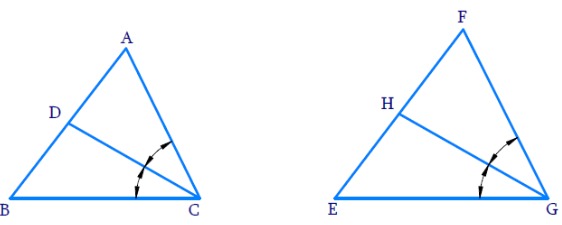
(i)
(i)
Solution:
∠ACB = ∠
⇒ ∠
⇒ ∠ACD = ∠
In ∆ADC and ∆FHG
∠DAC = ∠
∠ACD = ∠
Thus, ∆ADC ~ ∆
⇒
(ii)
(ii)∆DCB ~ ∆HGE
Solution:
In ∆DCB and ∆
∠DBC = ∠
∠DCB = ∠
Thus, ∆DCB
(iii)
(iii) ∆DCA ~ ∆HGF
Solution:
In ∆DCA and ∆
∠DAC = ∠
∠ACD = ∠
Thus, ∆DCA ~ ∆
11. In Fig, E is a point on side CB produced of an isosceles triangle ABC with AB = AC. If AD ⊥ BC and EF ⊥ AC, prove that ∆ ABD ~ ∆ ECF
Solution:

In ΔABD and Δ
∠ADB = ∠EFC =
∠ABD = ∠
Thus we have ΔABD
12. Sides AB and BC and median AD of a triangle ABC are respectively proportional to sides PQ and QR and median PM of ∆ PQR (see Fig. ). Show that ∆ ABC ~ ∆ PQR
Solution:

In ΔABC and ΔPQR
AD and PM are median of ΔABC and ΔPQR respectively
⇒
Now, in ΔABD and ΔPQM
⇒ ΔABD ∼ Δ
Now, in ΔABC and ΔPQR
∠ABC = ∠
⇒ ΔABC
13. D is a point on the side BC of a triangle ABC such that ∠ADC = ∠ BAC. Show that
Solution:
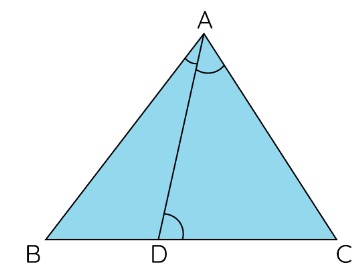
In ΔABC and Δ
∠BAC = ∠
∠ACB = ∠
⇒ ΔABC ∼ Δ
If two triangles are similar, then their corresponding sides are proportional
⇒
⇒
Hence, proved.
14. Sides AB and AC and median AD of a triangle ABC are respectively proportional to sides PQ and PR and median PM of another triangle PQR. Show that ∆ABC ~ ∆ PQR
Solution:

In ΔABD and Δ
AD =
BD =
∠ADB = ∠
Therefore, ΔABD ≅ ΔECD [By SAS criterion of congruence]
⇒ AB = CE by
Also, in ΔPQM and ΔMNR
PM =
QM =
∠PMQ = ∠
Therefore, ΔPQM = Δ
⇒ PQ = RN
Now,
⇒
⇒
⇒
Therefore, ΔACE ~ Δ
Therefore, ∠CAE = ∠
Similarly, ∠BAE = ∠
Hence, ∠CAE + ∠BAE = ∠RPN + ∠
⇒ ∠BAC = ∠
⇒ ∠A = ∠
Now, In ΔABC and ΔPQR
∠A = ∠
Therefore, ΔABC ~ ΔPQR [By SAS similarity criterion]
15. A vertical pole of length 6 m casts a shadow 4 m long on the ground and at the same time a tower casts a shadow 28 m long. Find the height of the tower
Solution:

AB is the pole =
BC is the shadow of pole AB =
PQ is the tower = ?
QR is the shadow of the tower PQ =
In ΔABC and ΔPQR
∠ABC = ∠PQR =
∠BAC = ∠
⇒ ΔABC ∼ Δ
The ratio of any two corresponding sides in two equiangular triangles is always the same.
⇒
⇒
⇒ PQ =
⇒ PQ =
Hence, the height of the tower is 42 m.
16. If AD and PM are medians of triangles ABC and PQR, respectively where ΔABC ~ ΔPQR, prove that
Solution:

Given, ΔABC ∼ Δ
⇒ ∠ABC = ∠
⇒
⇒
⇒
In ΔABD and ΔPQM,
∠ABD = ∠
⇒ ΔABD
⇒
⇒
